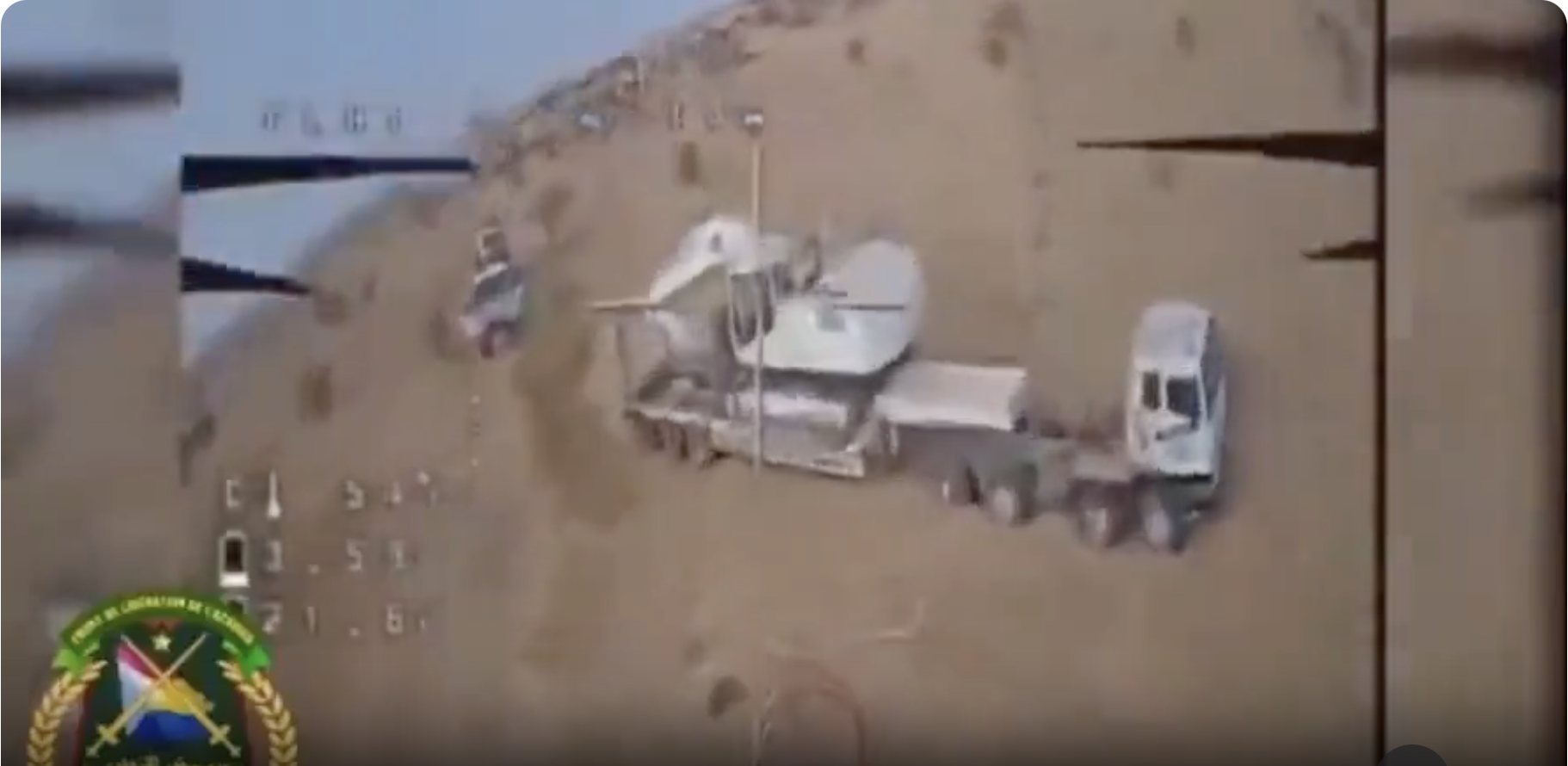African Non-State Actors Put Drones on the Attack

Published by The Lawfare Institute
in Cooperation With

Editor’s Note: Drones are changing the nature of warfare, and their use in Ukraine and possible use in various China-related scenarios has received considerable attention. Rueben Dass of the International Centre for Political Violence and Terrorism Research describes how terrorist and insurgent groups in Africa are using drones, explaining why they have shifted from intelligence gathering to attacks and why governments must up their anti-drone game.
Daniel Byman
***
The use of drones has become a ubiquitous reality of modern warfare. As in the Russia-Ukraine War, Myanmar’s civil war, and conflicts in the Middle East, drone use has also boomed in African conflict theaters in recent years. In Africa, like in Iraq and Syria in the mid-2010s, non-state actors (NSAs) have capitalized on the increasing accessibility of drones and have incorporated these weapons into their operations. The use of drones by NSAs in Africa dates back roughly to 2020 when they were used by Islamic State affiliates and Al-Shabaab for intelligence, surveillance, and reconnaissance (ISR), propaganda videography, and attack support. However, there has been a strategic shift in African NSAs’ use of drones from these passive missions to offensive use employing weaponized drones to carry out attacks. This shift in the use of drones by NSAs—including the Islamic State-West Africa Province (ISWAP), Jama’at Nusrat al-Islam wal Muslimin (JNIM), and several other Islamic State affiliates in Africa—is changing the threat landscape and will require African militaries to increase intelligence sharing and acquire new drone countermeasures.
Going on the Attack
Non-state actors in at least nine different African countries—Burkina Faso, Mali, Mozambique, Congo, Kenya, Libya, Nigeria, Somalia, and Sudan—have acquired and used drones. Islamic State affiliates, including the Islamic State-Mozambique and ISWAP, and al-Qaeda affiliate Al-Shabaab, were early adopters of drone technology, using them to provide real-time intelligence during attacks. The Islamic State-Mozambique, for example, used drones to identify ground targets and coordinate ground assaults on Mocimboa da Praia in May 2020 and Palma in March 2021. Similarly, the earliest reports of ISWAP’s use of drones for ISR and attack support date back to 2020, and in 2022, it released a propaganda video showcasing aerial footage that was shot using drones.
But ISWAP has gone further. The group is believed to have begun experimenting with modified attack drones to deliver explosive payloads sometime in 2022 or 2023, and in December 2024, it carried out its first armed drone attack against military installations in Wajiroko, Damaturu (Yobe State) and Abadam (Lake Chad). Four drones that were modified to carry improvised grenades were used in the attacks. The same month, Nigerian armed forces shot down an armed ISWAP drone approaching the headquarters of the 27 Task Force Brigade in Buni Gari.
JNIM, al-Qaeda’s affiliate in the Sahel, has also made significant progress in the weaponization of drones in Africa. A report by the Policy Center for the New South noted that JNIM has been able to carry out a sustained campaign of drone-enabled operations, incorporating both one-way attack strikes and ISR-guided ground assaults, in a campaign targeting Burkina Faso, Mali, and Togo. It is the only armed group on the continent to use drone attacks across three different countries. JNIM has carried out at least 17 armed drone attacks since September 2023. The group possesses first-person view (FPV) drones and Chinese-made DJI drones, such as the Matrice, Mavic 2, and Mavic 3, each with image stabilization and Global Positioning System (GPS) capabilities. Some of these drones have been modified to carry explosives.
The Azawad Liberation Front (ALF), a secessionist group that fights for the independence of the Azawad region in northern Mali, has also demonstrated an impressive use of drones in its operations. The group possesses several types of drones, including FPV drones, vertical take-off and landing (VTOL) drones, and, more recently, fiber optic drones that are less susceptible to electronic counter-drone jamming. The group used a Flydragon FDG410 surveillance drone capable of carrying a payload of up to 10 kilograms in an operation that took down a Malian army helicopter in Tessalit in February 2025 and other armed drones in a similar incident in Kidal in July 2024. The group has carried out at least 12 armed drone attacks since July 2024 targeting Malian and Russian forces. Fiber optic drones also have been used by Russian and Ukrainian forces in Eastern Europe and suggest that the ALF is learning from other conflicts and applying the lessons in their war in Mali.
In May 2025, the Islamic State-Sahel carried out an attack on military positions in Eknewan, Niger, using one-way attack drones. The attack killed 64 soldiers. The group, previously known as the Islamic State in the Greater Sahara, had used drones earlier for ISR, including to guide a ground assault on a military base in central Mali in August 2022. The May 2025 attack, like the previous cases, signals a shift in drone use. Similarly, the Islamic State-Somalia used armed drones against the Puntland Security Forces in Buuraha Cali Miskat in January 2025. This, coupled with several other improvised explosive device attacks by the group, resulted in the highest level of collective violence since 2017. Several similar drone attacks by the group were also intercepted by the security forces.
Al-Shabaab has lagged behind in weaponizing its drone fleet. It employed drones to coordinate and film an assault on a U.S. military base in Manda Bay, Kenya, in January 2020 but has not used armed drones in attacks yet. However, it is known to have recently begun using 3D printing to design drone components, prototypes, explosives, and weapons, and has recruited skilled personnel including engineers to enhance its drone capabilities.
Driving the Shift to Offensive Use
The shift from passive to offensive use of drones can be attributed to several factors. First, drones and the modifications necessary to weaponize them are more accessible than ever. Second, they are increasingly cost-effective, making them a useful tool for targeting government forces. And third, the efficacy of drones in other conflict theaters and access to expertise from foreign fighters and friendly state governments have influenced African NSAs to adopt them. NSAs are rarely passive observers to global conflicts and learn and incorporate tactics that work elsewhere.
Many commercial drones can be bought off the shelf and then modified to carry improvised explosives. Certain online retail sites even sell drop mechanisms that can be attached to drones to drop explosives. ISWAP and Al-Shabaab have also captured drones from government arsenals and used these to supplement their commercial acquisitions. This increasing availability, along with the proliferation of information online that has been made accessible by the growing use of internet networks such as Starlink, may well have added to the surge of drone use in the region.
Drones are a cheap but effective means for African NSAs to retaliate against government forces. African states have invested significantly in drone technology, with Turkey being the biggest supplier of drones to the region. At least 31 African countries have acquired drones, with nine countries embarking on their own domestic drone production programs. Ibrahim Yahaya Ibrahim of the International Crisis Group noted in an interview that the use of drones in these militaries’ counterterrorism missions has greatly affected the operations of NSAs in Mali and other countries, and this may have induced the NSAs targeted by these drones to adopt the technology as a means of counterattack.
As they have incorporated drones into their arsenals, African NSAs have benefited from the transfer of technology and expertise from external parties. For example, Ukrainian military intelligence is alleged to have provided the FLA and another Malian group, the Permanent Strategic Framework, with drones and training. Malian rebel groups’ use of fiber optic drones, which were first used in Ukraine, further reinforces this relationship. JNIM has also benefited from this knowledge transfer through FLA operative Col. Hussein Ghulam, who was linked to the FLA’s drone operations and joined JNIM in mid-2024. Ghulam likely boosted JNIM’s drone capabilities; the group’s drone activity has increased since he joined them.
ISWAP’s shift to offensive drone use can also be attributed to external knowledge transfer. A July 2025 UN Security Council report noted that 13 Islamic State trainers from the Middle East arrived in the Lake Chad basin in late 2024 to “facilitate the acquisition, assembly and deployment of drones” that are believed to have been used in subsequent attacks by ISWAP. Similarly, a Middle Eastern national was arrested for assisting the Islamic State-linked Allied Democratic Forces in Congo with drone development. According to an interview with Halkano Wario of the Institute for Security Studies, African NSAs may also have benefited from expertise of foreign fighters that have joined the organizations.
The Somalia-Yemen corridor and the nexus between Al-Shabaab, al-Qaeda in the Arabian Peninsula (AQAP), and the Houthis is another key avenue for knowledge transfer. Al-Shabaab and AQAP continue to maintain close ties with the Houthis despite their ideological differences. The Houthis have been proficient users of drones, benefiting from their Iranian links, and have transferred drone expertise to AQAP, facilitating AQAP’s use of weaponized drones since 2023. The UN has reported that Al-Shabaab sent several hundred fighters to Yemen to be trained by AQAP and to facilitate weapons acquisitions.
Al-Shabaab has also hosted Houthi officials in Somalia to discuss weapons acquisitions, which may be occurring. In September 2024, Puntland Security Forces arrested seven men smuggling commercial drones modified to carry explosives as they tried to move the drones into Somalia through Bosaso port. These drones were believed to have originated from the Houthis and were meant for Al-Shabaab. Despite their ideological differences and rivalries, the Islamic State-Somalia might have also established a pragmatic working relationship with the Houthis and Al-Shabaab for the purposes of weapons and expertise transfers. The Islamic State-Somalia carried out its first armed drone attack several months after the September 2024 arrest in Puntland.
African NSAs benefit from territorial strongholds that have enabled them to establish logistical supply routes and smuggling channels for the importation of hardware and expertise. During the height of its reign, the Islamic State exploited a large, uncontested territory in Syria and Iraq to experiment with and conduct drone operations often. Groups such as JNIM, FLA, ISWAP, and Al-Shabaab hold influence over significant amounts of territory that function as safe havens, which allow the groups space and time to experiment with drone technology.
Addressing a Changing Threat
African NSAs’ strategic shift toward the offensive use of drone technology highlights an interesting trend. Most groups start using drones passively for ISR and videography purposes before shifting to offensive use. This phase of early adoption and iteration allows for experimentation. Once groups hit the breakthrough and competition phases, drone use shifts from passive to offensive use. Passive use of drones may be a marker for future offensive use. If so, it is only a matter of time before groups that have been slow to employ weaponized drones, such as Al-Shabaab and the Islamic State-Mozambique, begin deploying one-way attack or munition drop drones.
This presents an evolving threat. Abdi Guled, a journalist and Horn of Africa analyst, noted in an interview that the threat is currently localized and characterized by frequent, low-cost attacks that are disruptive and affect the morale of government troops. He further noted that the destructive capacity remains limited by the quality of weapons and payload constraints. However, these barriers may be broken in due course, as evidenced by drone use in other conflicts where drones have become a force multiplier and game changer.
Counterterrorism agencies and governments facing these groups must equip themselves with necessary counter-drone capabilities that are still lacking in the region. Stronger regulatory and legislative frameworks must also be put in place to mitigate the illegal acquisition and use of drones. Finally, strong intelligence-sharing partnerships and joint counterterrorism cooperation between African nations will be vital to block illicit supply chains that facilitate the proliferation of drone technology among NSAs in the region.


.jpg?sfvrsn=d45482bc_5)

_-_flickr_-_the_central_intelligence_agency_(2).jpeg?sfvrsn=c1fa09a8_7)
